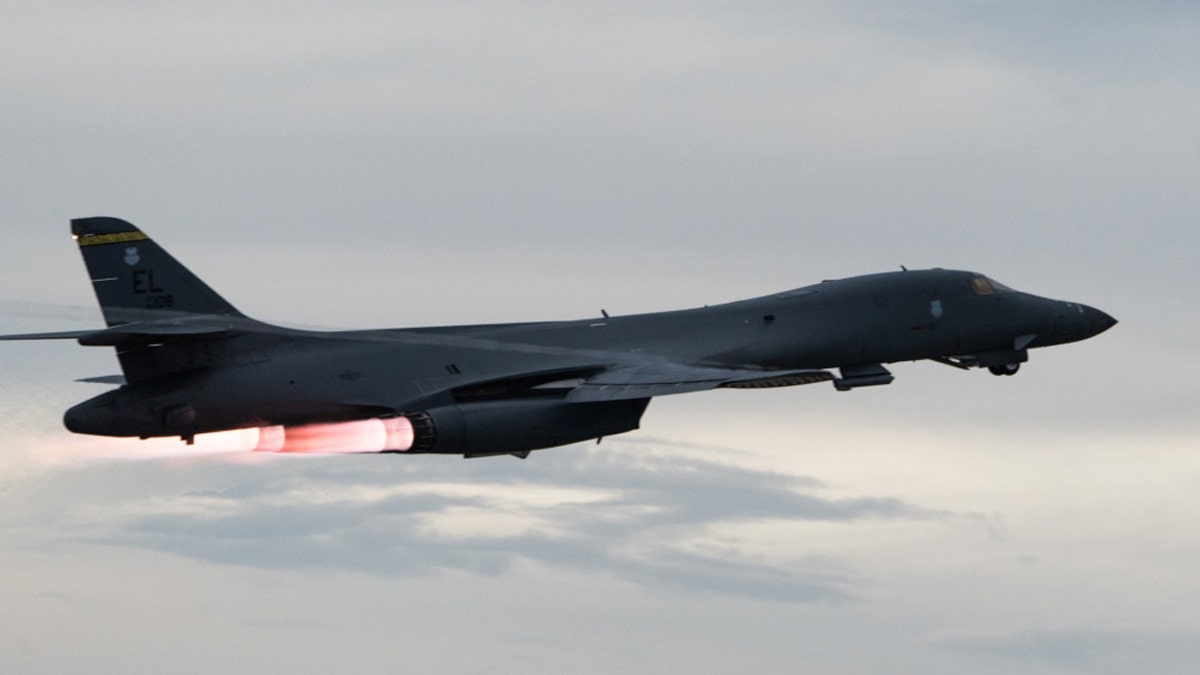
A U.S. Air Force B-1B Lancer takes-off to fly a bilateral mission with Japanese and South Korea Air Force jets in the vicinity of the Sea of Japan, from Andersen Air Force Base, Guam, October 10, 2017.
Over the skies of South Korea Wednesday, dramatic photos showed an Air Force supersonic bomber with U.S. and allied fighter jets in formation.
But there were supposed to be two Air Force bombers flying together.
In another sign of the maintenance challenges facing the U.S. military after years of budget cuts, the Air Force B-1B bomber that flew to South Korea from Guam on Wednesday was forced to leave behind its wingman.
The second bomber reported a maintenance issue while taxiing to the runway for takeoff, according to an Air Force officer who requested anonymity because he was not authorized to speak to the media.
“We only had a 30-minute launch window to meet the tanker,” while flying from Guam to South Korea the officer said.
The B-1B was taking part in the annual “Vigilant ACE” air exercises which included fifth-generation F-22 and F-35 stealth fighter jets for the first time. Overall, more than 230 aircraft between the United States and South Korea are taking part in the five-day exercise which concludes Friday.
U.S. Air Force officials said the training mission over South Korea required only one bomber. They said the second bomber was backup, but two were scheduled to launch Wednesday.
“If this had been war, that other bomber would have flown,” a senior Air Force official said. “It was a minor maintenance issue that was quickly corrected.”
The grounded American bomber was not the only glitch this week for the U.S. Air Force. A state-of-the-art F-22 stealth fighter jet was towed from the runway after landing in South Korea this week, although the Air Force later found no problems with the aircraft, according to Stars and Stripes.
The fact only half the number of B-1B bombers were able to carry out its training mission Wednesday falls roughly in line with the mission capability rates of the Air Force’s B-1 fleet. Today, only about half the B-1s in the inventory can fly. The Air Force is nearly 2,000 pilots and about 4,000 aircraft mechanics short. Spare parts are hard to come by for the bomber that first entered service in the 1980s.
The shortage has become so bad that some bomber air crews are forced to scrounge for parts in a remote desert scrapheap known as “The Boneyard.”
Twenty years ago, B-1s averaged roughly 1,000 flight hours on their air frames. Today, that number in many cases exceeds 10,000 hours.
When Fox News visited a B-1 base in South Dakota in 2016, a similar scene played out to the one in Guam Wednesday.
Two B-1 bombers were supposed launch from Ellsworth Air Force Base to fly nearly 1,000 miles south to White Sands Missile Range in New Mexico for a live-fire exercise.
On that day though, only one of the two B-1s that taxied to the runway was able to take off and make the training mission on time. The other sat near the runway for two hours. It eventually took off but was unable to participate in the live-fire exercise and diverted to a different mission, its crew missing out on valuable training at White Sands.
It is not immediately clear why a spare bomber was not available from Guam to complete the training mission.
There are only six B-1B bombers currently deployed to Guam, and today, one unable to complete the mission.




















